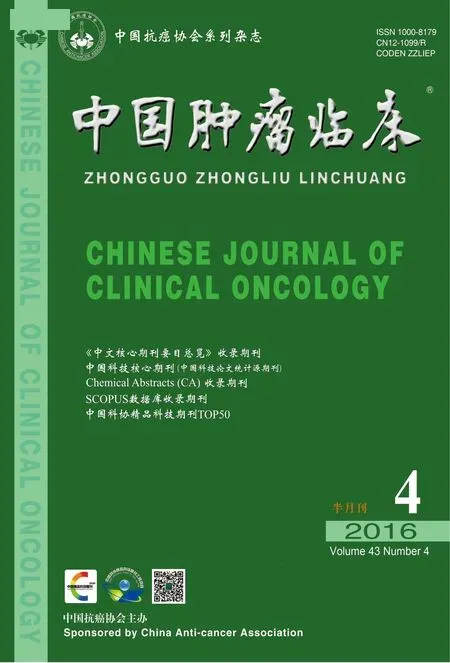抗凝对非小细胞肺癌治疗的机制研究
马敏婷 刘承媛 综述 魏素菊 审校
抗凝对非小细胞肺癌治疗的机制研究
马敏婷刘承媛综述魏素菊审校
近年来越来越多的研究开始关注恶性肿瘤患者并发的凝血功能异常,不仅导致血栓形成,还与肿瘤的生长、浸润侵袭、转移等密切相关,从而直接影响预后。肝素作为传统抗凝剂已众所周知,且抗凝药物已出现在恶性肿瘤治疗指南中。美国临床肿瘤学会(ASCO)、欧洲肿瘤内科学会(ESMO)以及美国临床药学学会(ACCP)等机构推荐低分子肝素作为治疗癌症相关血栓的首选,然而预防性应用抗凝药物对控制恶性肿瘤、延长PFS及OS的机制仍不明确。本文将从多方面介绍抗凝药物对控制恶性肿瘤的复发转移及延长生存的病理生理学机制。
恶性肿瘤高凝机制抗凝治疗非小细胞肺癌
19世纪Jean首次指出癌症与血栓相关,随后Armand Trousseau报道了胃癌与静脉血栓的联系[1]。恶性肿瘤患者血液呈高凝状态,并发血栓相关疾病风险提高,如DVT、PE及动脉闭塞相关中风及心绞痛[2]。Horste一项荟萃分析提示癌症患者静脉血栓发生率升高,平均风险发生率约每年13/1 000(95%CI,7-23)[3]。最近发布的《2012年中国恶性肿瘤发病及死亡分析》报告提示肺癌发病率及死亡率位居第1位。其相关致死率继疾病本身排名第2[4]。然而研究发现传统抗凝药物及新型抗凝血药物具有抗肿瘤功能。
1 抑制组织因子
组织因子(TF)是凝血级联反应过程中主要的激活因子,启动外源性凝血系统。在恶性肿瘤等病理情况下,TF高度表达,为肿瘤进展的决定因素及主要驱动程序[5-6]。TF高表达可激活凝血系统,诱发血栓形成肿瘤细胞保护层,有助于其免疫逃逸[7],同时诱发肿瘤生长和肿瘤血管生成。有实验探索了以TF作为靶点的共轭抗体药物(antibody-drug conjugate,ADC)即TF HuMab,证明其可快速目标内化,杀伤抑制肿瘤细胞,故TF HuMab可能成为抑制肿瘤的新型靶点治疗[8-9]。一项研究证实NSCLC细胞中TF的下调减少了裸鼠肿瘤的生长[10],抑制和调控TF的表达可控制肿瘤的进展。胰腺癌中应用低分子肝素后循环中表达的TF水平相对对照组明显降低[11]。低分子肝素可抑制癌细胞生长[12]。Ettelaie等[13]用不同浓度的低分子量肝素培养5种癌细胞,结果发现癌细胞通过胶原蛋白-Ⅳ侵袭受到抑制,细胞迁移的速度明显减少,且侵袭与转移速率的下降也与TF蛋白表达及其活动减少有密切关系。低分子量肝素抑制TF的表达可能与NFκB有关。实验研究数据表明Ⅶa和TF相互反应激活PAR2,从而激活ERK1/2和IκBα/NF-κB信号转导通路κ调节IL-8,TF和Caspase-7基因表达,并最终促进肿瘤细胞转移[14]。另外低分子量肝素可影响NFκB介导的组织因子mRNA的表达从而抑制肿瘤增长[13]。Versteeg等[15]研究证实组织因子抑制剂可阻碍肿瘤生长,其可直接抑制TF-Ⅶa途径,不仅抑制PAR2的激活,同时扰乱了TF的相互整合。Ixolaris作为TF-FⅦa-Ⅹa凝血起始复合物抑制剂应用在胶质母细胞瘤和黑色素瘤模型中,证明其通过TF信号复合物专门抑制PAR2,来抑制原发肿瘤生长及血管生成[16]。
2 抑制血管内皮生长因子
血管内皮生长因子(VEGF)启动血管生成需uPA 和uPAR(尿激酶型纤溶酶原激活物/尿激酶受体)系统的细胞外基质蛋白降解,uPAR为VEGF介导血管生成及肿瘤转移的关键点[17]。尿激酶原激活剂对肿瘤细胞最初转移至关重要,一项利用高度侵袭性人类恶性肿瘤(PC-hi/diss)作为实验,证实肿瘤细胞通过生成纤溶酶,激活肿瘤衍生的uPA促进肿瘤细胞向血管内游走逃生。此外,通过体内外实验证实PC-hi/ diss入侵、逃逸和传播可能通过基质蛋白裂解产生uPA增强纤溶酶。进一步研究指出尿激酶型纤溶酶原激活物抑制剂可抑制肿瘤侵袭[18]。另外,VEGF也可上调内皮细胞uPA、uPAR的表达。肝素及含特殊化学修饰的肝素制品可与各种内源性蛋白结合,其中就包括多种血管生成因素,并显示出良好的抑制信号通路作用。肿瘤细胞发生转移的前提是与内皮细胞(ECs)相互作用,ECs的激活可释放血管性血友病因子(vWF),在小鼠肿瘤模型中,ECs激活后释放vWF并发生血小板聚集,在缺乏VWF环境下应用低分子肝素阻断ECs激活可抑制肿瘤恶化[19]。miR-10b过表达可诱导细胞迁移、血管形成,在血管内皮细胞中肝素可以下调其表达[20]。低分子肝素牛磺胆酸钠结合物具有低抗凝活性,在小鼠模型中,其抗凝活性约为低分子肝素的12.7%,但其可强烈抑制VEGF依赖性受体磷酸化[21]。
3 抑制选择素
选择素(selectin)是血管细胞黏附分子,介导肿瘤细胞与血小板、白细胞和血管内皮细胞相互作用,肝素阻断选择素与肿瘤细胞表面黏蛋白配体结合,从而阻断上述细胞相互聚集,抑制了肿瘤细胞的转移[22]。实验对P-选择素、L-选择素缺失的小鼠接种黑色素瘤前短时间内注射肝素,结果为P-选择素缺失的小鼠组对单剂量注射肝素在肿瘤转移方面没有影响,而L-选择素缺失组肿瘤的转移降低,证明肝素抑制肿瘤转移作用与选择素有关。而肝素抑制肿瘤转移中L-选择素可能在P-选择素之后表现[23]。最近研究人员从海洋无脊椎动物中提取了一种肝素类似物(HS),可抑制P-选择素,且不引起出血,在肺癌细胞实验证实软体动物的硫酸乙酰肝素(HS)可大大减弱血小板与肿瘤细胞形成复合物[24]。
4 抑制凝血酶
凝血酶(Thrombin)是凝血级联反应中的主要效应蛋白酶,显现出促凝和抗凝的特性。凝血酶催化纤维蛋白原转化为纤维蛋白,促进血块稳定。凝血酶不仅可使肿瘤细胞对细胞因子的增殖反应增强,还增强肿瘤细胞与血小板的黏附及细胞基质的侵袭,增强肿瘤血管生成及肿瘤微环境的组织重建。凝血酶通过肿瘤细胞中高表达的PARs-1(蛋白酶活化受体)促进侵袭和发展[25]。凝血酶可激活MMP-2,破坏细胞基底膜,促进肿瘤纤维蛋白基质中肿瘤细胞增殖。抗凝血酶Ⅲ(AT-Ⅲ)是最重要的天然凝血酶抑制剂。APC(活化的蛋白C)可与受体PAR-1或EGFR结合,通过启动MAPK和PI3K信号途径通路促肿瘤的增长,与细胞外MMP-2和MMP-9作用降解细胞外基质,从而促进肿瘤转移[26]。在动物模型中,凝血酶抑制剂-水蛭素可以减少肿瘤的生长[27]。肝素抗凝作用主要通过与抗凝血酶Ⅲ(AT-Ⅲ)结合,增强抑制Ⅱ、Ⅸ、Ⅹ、Ⅺ和Ⅻ凝血因子的活化作用,阻碍血栓形成。达比加群脂是新一代口服抗凝药物,为凝血酶抑制剂,在4T1小鼠肿瘤模型中,凝血酶抑制剂与化疗药物联合组较单独应用达比加群脂或化疗药物组相比肿瘤细胞更小、肺转移更少。数据显示单独应用达比加群脂组抑制肿瘤诱导循环的TF+微粒释放,也使肿瘤诱导活化血小板数减少40%,表明达比加群脂对预防血栓及治疗恶性肿瘤是有益的[28]。
5 抑制肝素酶
肝素酶(heparanase)可裂解硫酸乙酰肝素蛋白糖的硫酸乙酰肝素(HS)侧链,上调VEGF-A、VEGF-C和参与细胞存活及增殖活化的信号通路。可上调TF表达,并与内皮细胞及肿瘤细胞表面的TFPI相互作用,使TFPI解体,增加凝血活性[29]。肿瘤细胞肝素酶高表达,与转移密切相关。利用人体黑色素瘤细胞研究证实肝素酶具有潜在临时紧密结合VLA-4整合蛋白活性,这是黑色素瘤转移扩散的重要组成部分。SDC-4为传递肝素酶复合物的蛋白多糖,通过黏着斑蛋白染色,证实SDC-4可上调VLA-4,低分子肝素虽不能代替肝素酶结合SDC-4,但可与其竞争性结合,并且低分子肝素可阻断肝素酶,有降低VLA-4的功能[30]。作为硫酸乙酰肝素的类似物,肝素与肝素酶亲和力很高,同时肝素酶可降解肝素,替换硫酸乙酰肝素作为肝素酶的底物,肝素被认为是肝素酶的有效抑制剂。有研究[31]表明肝素的硫酸化程度与抑制肝素酶活性的程度密切相关。肝素通过与肿瘤细胞起源的内皮细胞相互作用,对其细胞外信号调节激酶传导途径下游的磷酸化起到抑制作用[32]。也可通过抑制黏着斑激酶(FAK)表达,阻止肿瘤细胞向纤连蛋白基底膜黏附[33]。PG545是硫酸乙酰肝素的类似物,具有抗血管、乙酰肝素酶作用,乙酰肝素酶通过切割细胞外基质的HS造成细胞播散及转移,而PG545正作用在此关键点,乳腺癌模型中,其显著抑制肿瘤生长及肺转移[34]。
6 抑制血小板
肿瘤患者血小板(PLT)偏高,肺癌患者中更为普遍。血液高凝状态、血小板聚集增多可导致肿瘤转移。血小板颗粒中富含各种生长因子和趋化因子,可上调促血管新生介质的表达,促进肿瘤增长[35-36]。血小板活化可释放大量转化生长因子β(TGFβ),激活TGFβ/Smad和NF-κB信号转导通路,诱导肿瘤细胞类上皮间质转换,肿瘤细胞转移潜能提高。血小板衍生微粒可表达和转运功能性受体,刺激细胞因子的释放,激活细胞内PI3K-Akt、ERK信号转导通路,促进肿瘤血管生成和远处转移[37]。Gil-Bernabe等[38]研究指出血小板血栓快速与单核巨噬细胞聚集与肺转移的发生密切相关。在MCF-7细胞中血小板暴露于肝素显著减少,VEGF和血管生成潜力的降低。抗凝剂通过干扰PAR1可减少凝血酶生成。进一步研究证实在抗凝剂中加入PAR1受体激动剂,VEGF释放和血管生成潜力增加,而当加入PAR1受体拮抗剂,则出现了降低。故抗凝治疗通过减少血小板生成血管的潜力而延长肿瘤患者生存期、控制转移[39]。
7 展望
目前抗凝药物的研究非常多,而肝素常常用于预防和治疗肿瘤相关的血栓栓塞,越来越多临床证据表明:肝素可提高肿瘤患者生存,动物模型中证明可减弱转移能力。肝素需每天皮下注射和诱导血小板减少,近年来口服抗凝剂具有代替肝素常规治疗的潜力[40]。然而抗凝对控制恶性肿瘤的具体机制仍不明确,仍需进一步探索。
[1]Timp JF,Braekkan SK,Versteeg HH,et al.Epidemiology of cancerassociated venous thrombosis[J].Blood,2013,122(10):1712-1723.
[2]Khorana AA.Cancer-associated thrombosis:updates and controversies[J].Hematology Am Soc Hematol Educ Program,2012,2012:626-630.
[3]Horsted F,West J,Grainge MJ.Risk of venous thromboembolism in patients with cancer:a systematic review and meta-analysis[J]. PLoS Med,2012,9(7):e1001275.
[4]Elyamany G,Alzahrani AM,Bukhary E.Cancer-Associated Thrombosis:An Overview[J].Clinical Medicine Insights:Oncology,2014,8:129-137.
[5]van den Berg YW,Osanto S,Reitsma PH,et al.The relationship between tissue factor and cancer progression:insights from bench and bedside[J].Blood,2012,119(4):924-932.
[6]Ruf W.Tissue factor and cancer[J].Thromb Res,2012,130(1):S84-S87.
[7]Gil-Bernabe AM,Ferjancic S,Tlalka M,et al.Recruitment of monocytes/macrophages by tissue factor-mediated coagulation is essential for metastatic cell survival and premetastatic niche establishment in mice[J].Blood,2012,119(13):3164-3175.
[8]Breij EC,de Goeij BE,Verploegen S,et al.An antibody-drug conjugate that targets tissue factor exhibits potent therapeutic activity against a broad range of solid tumors[J].Cancer Res,2013,74(4):1214-1226.
[9]Koga Y,Manabe S,Aihara Y.Antitumor effect of antitissue factor antibody-MMAE conjugate in human pancreatic tumor xenografts[J]. Int J Cancer,2015,137(6):1457-1466.
[10]Xu C,Gui Q,Chen W,et al.Small interference RNA targeting tissue factor inhibits human lung adenocarcinoma growth in vitro and in vivo[J].J Exp Clin Cancer Res,2011,30(1):63-73.
[11]Maraveyas A,Ettelaie C,Echrish H,et al.Weight-adjusted dalteparin for prevention of vascular thromboembolism in advanced pancreatic cancer patients decreases serum tissue factor and serummediated induction of cancer cell invasion[J].Blood Coagul Fibrinolysis,2010,21(5):452-458.
[12]Sudha T,Yalcin M,Lin HY,et al.Suppression of Pancreatic Cancer by Sulfated Non-Anticoagulant Low Molecular Weight Heparin[J].Cancer Lett,2014,350(1-2):25-33.
[13]Ettelaie C,Fountain D,Collier ME,et al.Low molecular weight heparin down regulation tissue factor expression and activity by modulating growth factor receptor mediated induction of nuclear factor-KB[J].Biochimica et Biophsica Acta,2011,1812(12):1591-1600.
[14]Guo D,Zhou H,Wu Y.Involvement of ERK1/2/NF-κB signal transduction pathway in TF/FVIIa/PAR2-induced proliferation and migration of colon cancer cell SW620[J].Tumour Biol,2011,32(5):921-930.
[15]Versteeg HH,Schaffner F,Kerve M,et al.Inhibition of tissue factor signaling suppresses tumor growth[J].Blood,2008,111(1):190-199.
[16]Carneiro-Lobo TC,Schaffner F,Disse J,et al.The tick-derived inhibitor Ixolaris prevents tissue factor signaling on tumor cells[J].J Thromb Haemost,2012,10(9):1849-1858.
[17]Alexander RA,Prager GW,Mihaly-Bison J,et al.VEGF-induced endothelial cell migration requires urokinase receptor(uPAR)-dependent integrin redistribution[J].Cardiovasc Res,2012,94(1):125-135.
[18]Botkjaer KA,Deryugina EI,Dupont DM,et al.Targeting tumor cell invasion and dissemination in vivo by an aptamer that inhibits urokinase-type plasminogen activator through a novel multifunctional mechanism[J].Mol Cancer Res,2012,10(12):1532-1543.
[19]Bauer AT,Jan S,Frank K,et al.von Willebrand factor fibers promote cancer-associated platelet aggregation in malignant melanoma of mice and humans[J].Blood,2015,125(20):3153-3163.
[20]Shen X,Fang J,Lv X,et al.Heparin Impairs Angiogenesis through Inhibition of MicroRNA-10b[J].J Biol Chem,2011,286(30):26616-26627.
[21]Lee E,Kim YS,Bae SM,et al.Polyproline-type helicalstructured lowmolecular weight heparin(LMWH)-taurocholate conjugate as a new angiogenesis inhibitor[J].Int J Cancer,2009,124(12):2755-2765.
[22]Laubli H,Stevenson JL,Varki A.L-Selectin Facilitation of Metastasis Involves Temporal Induction of Fut7-Dependent Ligands at Sites of Tumor Cell Arrest[J].Cancer Res,2006,66(3):1536-1542.
[23]Borsig L.Antimetastatic activities of heparins and modified heparins,Experimental evidence[J].Thromb Res,2010,125(2):s66-71.
[24]Gomes AM,Kozlowski EO,Borsig L.Antitumor properties of a new non-anticoagulant heparin analog from the mollusk Nodipecten nodosus:Effect on P-selectin,heparanase,metastasis and cellular recruitment[J].Glycobiology,2015,25(4):386-393.
[25]Wojtukiewicz MZ,Hempel D,Sierko E,et al.Protease-activated receptors(PARs)-biology and role in cancer invasion and metastasis [J].Cancer Metastasis Rev,2015,34(4):775-796.
[26]Gramling MW,Beaulieu LM,Church FC.Activated protein C enhances celI motility of endothelial cells and MDA-MB-231 breast cancer cells by intracellular signal transduction[J].Exp CeIl Ras,2010,316 (3):314-328.
[27]Nierodzik ML,Karpatkin S.Thrombin induces tumor growth,metastasis,and angiogenesis:Evidence for a thrombin-regulated dormant tumor phenotype[J].Cancer Cell,2006,10(5):355-362.
[28]Alexander ET,Minton AR,Hayes CS,et al.Thrombin Inhibition and Cyclophosphamide Synergistically Block Tumor Progression and Metastasis[J].Cancer Biol Ther,2015,16(12):1802-1811.
[29]Nadir Y,Brenner B.Heparanase multiple effects in cancer[J].Thromb Res,2014,133(2):S90-94.
[30]Gerber U,Hoß SG,Shteingauz A.Latent heparanase facilitates VLA-4-mediated melanoma cell binding and emerges as a relevant target of heparin in the interference with metastatic progression[J]. Semin Thromb Hemost,2015,41(2):244-254.
[31]Sanderson RD,Iozzo RV.Targeting heparanase for cancer therapy at the tumor-matrix interface[J].Matrix Biol,2012,31(5):283-284.
[32]McCubrey JA,Steelman LS,Franklin RA,et al.Franklin targeting the RAF/MEK/ERK,PI3K/AKT and P53 pathways in hematopoietic drug resistance[J].Adv Enzyme Regul,2007,47:64-103.
[33]Chalkiadaki G,Nikitovic D,Berdiaki A,et al.Heparin plays a key regulatory role via a p53/FAK-dependent signaling in melanoma cell adhesion and migration[J].IUBMB Life,2011,63(2):109-119.
[34]Hammond E,Brandt R,Dredge K.PG545,a heparan sulfate mimetic,reduces heparanase expression in vivo,blocks spontaneous metastases and enhances overall survival in the 4T1 breast carcinoma model[J].PLoS One,2012,7(12):e52175.
[35]Gay LJ,Felding-Habermann B.Contribution of platelets to tumour metastasis[J].Nat Rev Cancer,2011,11(2):123-134.
[36]Sabrkhany S,Griffioen AW,Oude Egbrink MG.The role of blood platelets in tumor angiogenesis[J].Biochim Biophys Acta,2011,1815(2):189-196.
[37]Varon D,Hayon Y,Dashevsky O,et al.Involvement of platelet derived microparticles in tumor metastasis and tissue regeneration[J]. Thromb Res,2012,130(1):S98-99.
[38]Gil-Bernabe AM,Ferjancic S,Tlalka M,et al.Recruitment of monocytes/macrophages by tissue factor-mediated coagulation is essential for metastatic cell survival and premetastatic niche establishment in mice[J].Blood,2012,119(13):3164-3175.
[39]Battinelli EM,Markens BA,Kulenthirarajan RA,et al.Anticoagulation inhibits tumor cell-mediated release of platelet angiogenic proteins and diminishes platelet angiogenic response[J].Blood,2014,123(1):101-112.
[40]Prandoni P.The treatment of cancer-associated venous thromboembolism in the era of the novel oral anticoagulants[J].Expert Opin Pharmacother,2015,16(16):2391-2394.
(2015-12-08收稿)
(2016-01-15修回)
(编辑:杨红欣校对:周晓颖)

马敏婷专业方向为恶性肿瘤的诊断及化疗、靶向等治疗。
E-mail:996243716@qq.com
Mechanism of anticoagulation therapy for non-small cell lung cancer
Minting MA,Chengyuan LIU,Suju WEI
Correspondence to:Suju WEI;E-mail:weisuju@126.com
Department of Medical Oncology,Fourth Hospital of Hebei Medical University,Shijiazhuang 050011,China
In recent years,a number of studies have focused on malignant tumor patients with coagulant function abnormality,which causes thrombus complications,tumor growth,infiltration of closely related cells,transfer,and so on.These factors directly affect prognosis.Heparin is a widely known anticoagulant,and anticoagulation drugs have been included in malignant tumor treatment guidelines.Ameaican Society of Clinical Oncology(ASCO),European Society for Medical Oncology(ESMO),and American College of Clinical Pharmacy(ACCP)recommend low-molecular-weight heparin as the first choice for the treatment of cancer thrombosis.However,the prophylactic use of anticoagulant drugs in patients with tumor control disease,as well as the prolonged PFS and OS mechanism,is still unclear.The recently published"Report of incidence and mortality in China"(2012)suggests that lung cancer incidence and mortality ranked first place.This review will introduce several aspects of anticoagulant drugs that can be used to control the recurrence of malignant tumor metastasis and prolong the survival mechanism of pathophysiology.
malignant tumor,high coagulation mechanism,anticoagulant therapy,non-small cell lung cancer
10.3969/j.issn.1000-8179.2016.04
河北医科大学第四医院肿瘤内科(石家庄市050011)
魏素菊Weisuju@126.com

